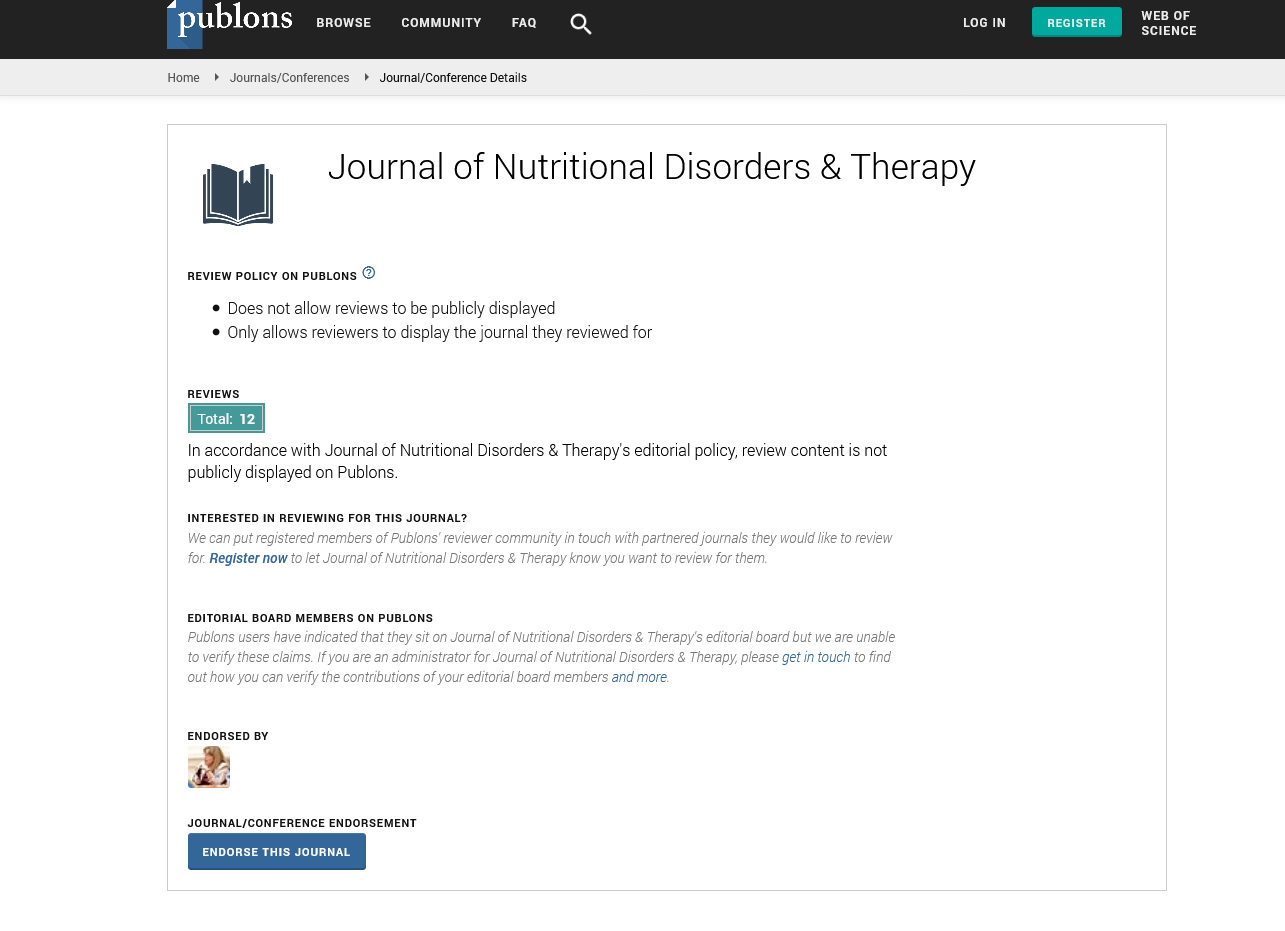Indexed In
- Open J Gate
- Genamics JournalSeek
- Academic Keys
- JournalTOCs
- Ulrich's Periodicals Directory
- RefSeek
- Hamdard University
- EBSCO A-Z
- OCLC- WorldCat
- Publons
- Geneva Foundation for Medical Education and Research
- Euro Pub
Useful Links
Share This Page
Journal Flyer

Open Access Journals
- Agri and Aquaculture
- Biochemistry
- Bioinformatics & Systems Biology
- Business & Management
- Chemistry
- Clinical Sciences
- Engineering
- Food & Nutrition
- General Science
- Genetics & Molecular Biology
- Immunology & Microbiology
- Medical Sciences
- Neuroscience & Psychology
- Nursing & Health Care
- Pharmaceutical Sciences
Short Communication - (2025) Volume 15, Issue 1
Variations in Choroidal Metrics among Children Experiencing Malnutrition
Senem Ekici*Received: 25-Feb-2025, Manuscript No. JNDT-25-29111; Editor assigned: 27-Feb-2025, Pre QC No. JNDT-25-29111 (PQ); Reviewed: 13-Mar-2025, QC No. JNDT-25-29111; Revised: 20-Mar-2025, Manuscript No. JNDT-25-29111 (R); Published: 27-Mar-2025, DOI: 10.35248/2161-0509.25.15.315
Description
Childhood malnutrition remains a global health concern, especially in low and middle-income countries. It affects growth, immunity and neurodevelopment, but its impact on ocular structures, particularly the choroid, has received limited attention until recently. The choroid, a vascular layer situated between the retina and the sclera, is vital for maintaining photoreceptor function. Advances in imaging technology, particularly Enhanced Depth Imaging Optical Coherence Tomography (EDI-OCT), have allowed clinicians and researchers to assess subtle changes in choroidal structure.
Among the measurable parameters, choroidal thickness and Choroidal Vascular Index (CVI) are regarded as indicators of vascular supply and tissue integrity. This article aims to explore how these two markers are affected in children suffering from malnutrition, focusing on observational data, physiological mechanisms and possible implications for broader health monitoring.
Malnutrition in childhood
Malnutrition encompasses undernutrition (stunting, wasting and underweight) and micronutrient deficiencies. Its etiology is multifactorial, involving inadequate food intake, infections, chronic disease and socio-economic factors.
The effects on growth and cognition are well documented, but its ocular consequences are often limited to corneal and conjunctival manifestations. Recent studies, however, point to more subtle retinal and choroidal involvement, suggesting that ocular imaging could serve as a non-invasive adjunct to assess systemic nutritional status.
Measurement tools
Enhanced Depth Imaging Optical Coherence Tomography (EDI-OCT) allows high-resolution cross-sectional imaging of the choroid. It provides quantitative data on:
- Choroidal Thickness (CT): Measured perpendicularly from the outer border of the Retinal Pigment Epithelium (RPE) to the inner scleral surface.
- Choroidal Vascular Index (CVI): Represents the ratio of luminal (vascular) area to total choroidal area in a given scan, reflecting the vascular component of the choroid.
CVI has emerged as a more stable metric than CT since it accounts for structural variability caused by age, hydration status and intraocular pressure.
Conclusion
Choroidal thickness and vascular index are promising indicators of ocular vascular health and may reflect systemic disturbances caused by childhood malnutrition. Evidence suggests that both parameters are reduced in affected children, potentially as a result of impaired vascular development, chronic inflammation and micronutrient deficits. While further validation is required, these non-invasive markers may contribute to a more holistic understanding of malnutrition's effects and open pathways for multidisciplinary research and monitoring.
References
- Njatang DK, Djourdebbé FB, Wadou ND. Climate variability, armed conflicts and child malnutrition in sub-saharan Africa: A spatial analysis in Ethiopia, Kenya and Nigeria. Heliyon. 2023;9(11).
- Manzo ML, Halidou MD, Wilmet MD, Donnen P. Trends in malnutrition among children under 5 in Niger: a retrospective analysis of demographic and nutrition surveys comparing 2008-2014 with 2015-2021. Public health. 2023;225:151-159.
- Öztürk ME, Ayhan NY. Evaluation of malnutrition and screening tools in hospitalized children. Clin Nutr ESPEN. 2023;57:770-778.
- He Q, Qi X, Zhang T, Tang K. Trends in socioeconomic inequalities in malnutrition among children under 5 in the Democratic Republic of the Congo from 2001 to 2018. Nutrition. 2023;115:112182.
- Gómez KR. Mapping obesity in women and chronic malnutrition in children across the municipalities of Bolivia: Spatial clusters and regionalization. Reg Sci Policy Pract. 2024;16(11):100129.
- Nguedjo MW, Tchuente BR, Ngoumen DJ, Mouafo HT, Dibacto RE, Fandio GC, et al. The phenotypes of double burden of malnutrition in pairs of mothers and their children aged 0-59 months at a rural district in west region, Cameroon: a cross-sectional study. Clin Epidemiol Glob Health. 2024;29:101743.
- Siddiqa M, Zubair A, Kamal A, Ijaz M, Aljeddani SM. Risk factors of child malnutrition under 5 years: Evidence from Pakistan using the Composite Index of Anthropometric Failure. Nutrition. 2024;127:112523.
- Muse AI, Osman MO, Ibrahim AM. Determinants of acute malnutrition among 6 to 59-months children in public health facilities. Clin Nutr Open Sci. 2025;59:56-67.
- Shen M, Li Y, Cui Z, Li X. Age heterogeneity in the association between malnutrition and early childhood development among children aged 0–5 years in a Chinese plateau area. Public Health. 2025;243:105737.
- Kudan ZB, Owolabi OA, Bala SM, Mohammed A. Treatment outcomes and predictors of recovery from severe acute malnutrition among children. Clin Nutr Open Sci. 2023;52:58-67.
Citation: Ekici S (2025). Variations in Choroidal Metrics among Children Experiencing Malnutrition. J Nutr Disord Ther. 15:315.
Copyright: © 2025 Ekici S. This is an open-access article distributed under the terms of the Creative Commons Attribution License, which permits unrestricted use, distribution, and reproduction in any medium, provided the original author and source are credited.

